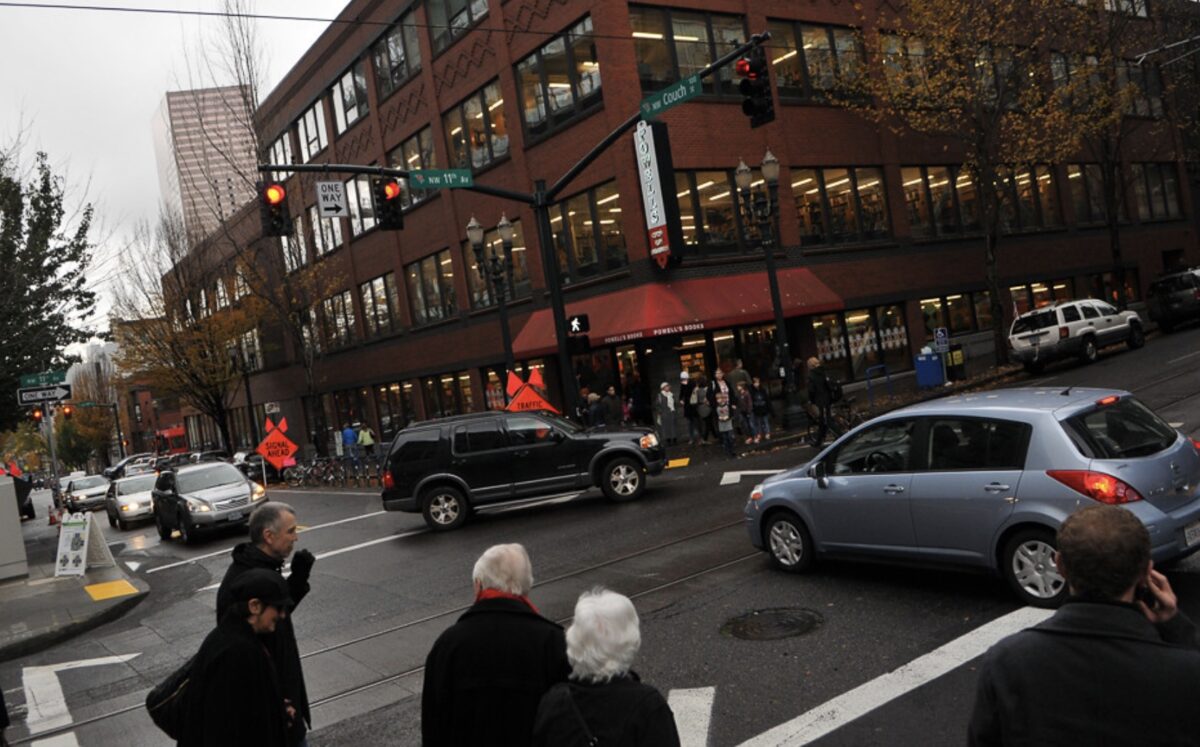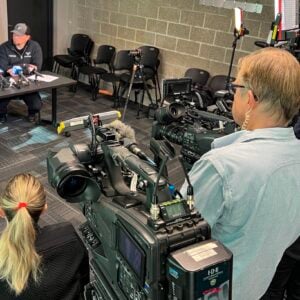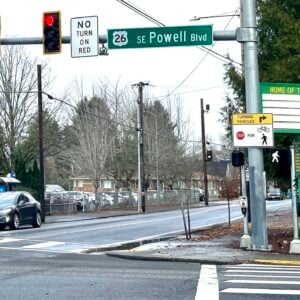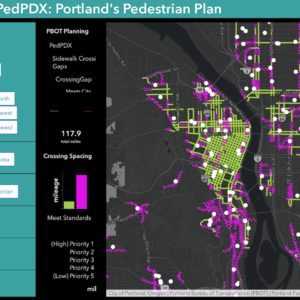
“The top causes of pedestrian deaths are mistakes made by sober, everyday drivers.”
— Vivek Jeevan, safety advocate
Speed kills, and it is the number one cause of pedestrian fatalities in Portland, according to a new independent analysis of crash data led by safety advocate Vivek Jeevan. His group of seven volunteers from BikeLoud PDX, a grassroots nonprofit advocacy group, worked with a statistician to comb through 48 police reports from Oregon Walks’ Fatal Pedestrian Crash Report (released earlier this year). Jeevan trained his group to look for driving and walking behaviors which led to the crashes. This behavioral approach is a noteworthy shift from the usual focus on infrastructure.
The top causes of pedestrian deaths, says Jeevan, “are mistakes made by sober, everyday drivers.”
Advertisement

The report itself is rigorous. Jeevan is a medical physicist and he brings the discipline of the medical sciences to this work: the volunteers followed a well-formulated protocol (PDF); each crash report was analyzed by two different volunteers; conflicting findings were resolved by Jeevan.

I asked him how he decided which “Causes” should be included. He responded that he had done a “literature review” which provided the foundation of the list. But he also wanted to dispel myths about behaviors that get a lot of attention but which are not causing fatalities. Pedestrians on phones running into crosswalks? “Those are issues which didn’t cause a single fatality in our dataset.” He went ahead and included them in the “Cause” column to better make that point.
The purpose of the study is to provide feedback and education about what behaviors to focus on to avoid pedestrian fatalities. For each “Cause,” a traffic instructor can teach a positive driving habit, or best practice, which would prevent it. For example, “Turn your head before your wheels” would prevent many turning movement crashes. “If you can’t see the crosswalk, don’t assume it’s clear.” To better see pedestrians, “look up, scan the horizon, and plan 30 seconds ahead.”
Jeevan points out that most drivers only plan five seconds ahead, and that twice as many pedestrians are killed inside crosswalks as outside.
This is not the type of talk I’m used to hearing from safety advocates. Of the three “E”s of road safety (engineering, enforcement and education) advocates understandably focus on engineering–road width, connectivity, bike lanes, crosswalks, lights. This not only provides a counterweight to an historic “blame-the-victim” tendency (the crash as “accident,” “the victim was wearing dark clothing,” “the cyclist was not wearing a helmet,” etc) but it can lead to improved street design which is known to save lives.
“I truly in my heart think that it takes two years to understand how to drive safely.”
— Vivek Jeevan
The second “E,” enforcement, is a hot-button issue given the role of fallible human enforcers. Education? Well, maybe it’s a little sleepy, it certainly gets short shrift–but it also happens to be Jeevan’s passion, “When someone is educated, it changes the way they walk, bike and drive.”
Jeevan is a recent transplant to Portland from Corvallis, where he founded and ran a non-profit to stand up for the transportation rights of vulnerable road users. Part of what they did was to reach out to drivers to promote conversations about safe driving. He is carfree, and also happens to be a League of American Bicyclists League Cycling Instructor. We talked last week about what it takes to create a “culture of safety,” and he mentioned that in his line of work, radiation oncology, a minimum of over two years of training is required before one qualifies to operate the powerful machines, and continuing education is a must. Yet, “these machines are less dangerous than cars, and what do we require in the way of driver education? I truly in my heart think that it takes two years to learn how to drive safely.”
Given that he is a daily bike rider, and used volunteers from BikeLoud, I asked Jeevan when he was going to do a similar report for crashes involving people on bicycles. “We would love to do cycle crashes next.”
Vivek Jeevan has only lived in Portland for just over a year, but he certainly hit the ground running. We look forward to following his continuing advocacy for vulnerable road users.

— Lisa Caballero, lisacaballero853@gmail.com
— Get our headlines delivered to your inbox.
— Support this independent community media outlet with a one-time contribution or monthly subscription.





Thanks for reading.
BikePortland has served this community with independent community journalism since 2005. We rely on subscriptions from readers like you to survive. Your financial support is vital in keeping this valuable resource alive and well.
Please subscribe today to strengthen and expand our work.
I wonder how much the top two numbers overlap, in the pedestrian fatalities chart. I.E. what % of the 72% drivers exceed safe speed and 42% driver fails to yield. Are those numbers overlapping or non-concurrent? Were all of the 42% accounted for in the 72%? If not, what is that delta number? Ultimately, I’m looking for the number of accidents caused by motorists. At least 72% but how much more?
I tracked the 2019 pedestrian fatalities and drivers were at fault 65% of the time. 17.5% of the time pedestrians were at fault. The remaining 17.5% were undetermined because of the vagueness of the police reports. The 65% includes all fatalities where the driver left the scene which was over half of that percent at 35%.
47% of the fatalities occurred in the roadway outside of a crosswalk. The remaining 53% were in a crosswalk 41%, on the sidewalk or in a recreational area (boat ramp) each 6%.
Wow. Very practical research! Welcome to pdx, Vivek!
This is a great report that goes against some of what I had previously assumed was likely, but you can’t argue with the data. I would have thought that the number of drivers distracted by mobile devices, and those who failed to obey traffic control devices, would have been larger. While 44% were failure to yield to a pedestrian in a crosswalk, larger than I would have thought.
I think this shows that we need more treatments like HAWK signals and the like, to make people crossing the road at crosswalks much more visible to oblivious drivers. People will obey these traffic control devices but they won’t obey yielding at unmarked/paint-only crosswalks, as shown in the data.
I’m always a bit taken aback by reported budgets for electronic traffic control considering the advances in lighting / networking tech.
Do you think any driver is going to admit to use of a mobile device? Do cops routinely check with cell phone companies to see if the motorist was connected?
All a motorist has to do is mutter the words “he stepped right out in front of me without warning.”
The PPB pulled out all the stops and did extensive analysis to “prove” that Mark Angeles, the bicyclist struck and killed by a tow truck driver at noon in May, was (maybe) exceeding the speed limit by three mph and was less than 60 feet from the signal when it turned to yellow. They all but exonerated the truck driver – just a ticket for failing to yield and a fine of a couple hundred dollars.
The analysis seems good, but the validity of the data is suspect because of how it was collected and reported.
They might be larger than reported. If I hit someone after looking at my phone, I’m probably not going to report that, and the report writer would have no other way to know. Instead, I’m going to say “the pedestrian came out of nowhere”, which would likely be coded as “driving too fast.”
I strongly suspect “driving too fast” is overrepresented because it serves as a bit of a catch-all. Some of the other categories, especially those that rely on driver self-reporting, are likely to be underrepresented.
You all (referring to all three commenters here who mention it) make good points on the distracted driving part. That being said, I still think that doesn’t detract from my conclusion that more HAWKS should be used. I’ll, as a walker or runner, gladly trade a 5-second delay after pressing the walk button for vastly increased safety.
I agree with your conclusion, though personally prefer the rapid flash beacons (flashing yellow ones) because they are instant gratification, and seem to work well, even on streets like Powell. I think many people find the HAWK signals confusing.
I appreciate the work being done here, but we need to be careful about conclusions based on a sample size of 48, and a source of POLICE REPORTS.
What raised my eyebrows was the driver distraction down at 4%!
Anyone who is out on the streets – car, bike, on foot – knows that distracted driving is epidemic … pandemic … just by anecdotes of seeing so many drivers cruising along with their eyes down!! It’s obviously very dangerous, and that doesn’t seem to come through here.
I write here because it feels like people are responding with pleasant surprise that distracted driving isn’t contributing significantly to pedestrian (injuries and) deaths … and that just feels wrong based on what we see every day.
Viv is a dedicated advocate and stalwart of all things safety. So glad you were able to talk to him and share this important research. Great article!
Thanks for the great reporting, this was very interesting. Is Jeevan’s full report publicly available? I am not seeing it linked in this story.
Hi Lowell, I’m not aware of Viv putting more online anywhere. If you look at the link in the 3rd paragraph, “well-defined protocol,” it has a lot of information about their methods. All I’ve seen are that, and the graphic at the top of the article.
I really appreciate this study, limited in scope as it is. Were the percentages based on police crash investigations? Guess I need to read that again.
I have one quibble with the title. Gas pedal pressure is applied by a consciously controlled muscular movement. When I drive 40 mph on, say, NE Prescott, it’s a choice and not a mistake.
yeah OK I agree. I tried to be too cute with the title. But it’s not worth the distraction from Lisa and Viv’s work! Changed it to: “New report analyzes driving behaviors that lead to pedestrian fatalities in Portland”
So, are you completely giving up on enforcement because of “fallible human enforcers?” I’m not, but then again, I’m an old white man.
Giving up on enforcement has led us to a record number of fatalities. Can we at least set a metric (maybe 150 traffic deaths per year) at which we will begin to consider planning for thinking about trying an increase in enforcement? Let’s have a task force and public involvement to actually try enforcement when it reaches one traffic death per day.
We’re already beyond the point at which we need to declare this a crisis and DO something about it. For goodness sake, let’s try enforcement.
This is a great dataset. I’m curious how it was determined if a vehicle was traveling too fast for conditions; unless the driver is doing something egregious, it can be a tricky thing to judge objectively.
“Behaviors defined:
Motorist Speed Excessive to Conditions – Oregon calls this the basic speed rule, stating in law that speed must be reasonable with respect to all traffic conditions. The practical way to understand this, as taught in traffic classes, is to imagine a child or log laying on the road. If you can stop in time, you’re traveling at speeds reasonable to conditions. We define the speed limit as exactly what it is, the limit of speed when all conditions are optimal (sunny, clear, etc). If conditions are less than optimal, speed must be decreased.
We tallied this when drivers exceeded the speed limit, or drove at/near the limit in conditions where they should have slowed (rain, darkness, crowded areas, etcetera). Drivers often admitted that they didn’t have enough time to stop, which means either the pedestrian entered the crosswalk too suddenly or the driver was too fast for conditions. We tallied this when drivers admitted that they didn’t have enough time to stop for the pedestrian, and evidence showed that the pedestrian had been in the crosswalk for a reasonable time for the driver to stop, and when other drivers were clearly able to avoid hitting the pedestrian”
A speed limit is a legal limit, not necessarily a reflection of what is safe. While I am pretty religious about following them, and wish others would be too, it is not accurate to say that someone driving 25 on a 20 MPH street is always violating safety limits (especially as safety is a gradient, not a binary). Nor is it automatic that driving 20 MPH on that same street at night is a concern. It might be, but it’s hardly a given. I think it is important to understand what this category actually means, and how incidents end up in it, when interpreting and communicating the data.
Most of the other categories seem much more specific and clear-cut (at least as much as is possible in a project like this).
While I agree safe speed is variable based on conditions, and I don’t think anyone is seriously arguing this point. If a driver is going over the posted speed limit they are definitionally driving at a speed excess of conditions. First, because the condition on the road is the speed limit, imposed by law, and second and most salient in regard to pedestrians, it puts too high a burden on pedestrians and drivers around the speeding car to judge the velocity and closing time between the car and other road users. When I walk out into an intersection I can reasonably expect drivers going at or below the speed limit to see an react to me in a given time. Add an outlier, speeder, to the mix and this judgment is impaired.
We expect drivers to generally be going a certain speed, and when they don’t it negatively effects our ability to move safety in proximity to them. That speed it set by law and posted, when you exceed and you hit someone, your are at fault, at minimum shared fault, but you now have to prove the other parties actions were inappropriate regardless of your speeding, which is a difficult task.
In my opinion the biggest cause of the increased traffic fatalities is the lack of enforcement in Portland and the lawless climate created by this vacuum. Drivers speed and drive recklessly because they know there are essentially zero repercussions.
After 30 years of driving cars and riding bikes around Portland I can think of two places where I would not be surprised to see a traffic officer. Those are the Sunset Highway west bound by the cemetary, and Ladd Circle.
I kind of want to print “Pedestrian distracted by electronic device 0%” and force Jo Ann Hardesty to eat it.